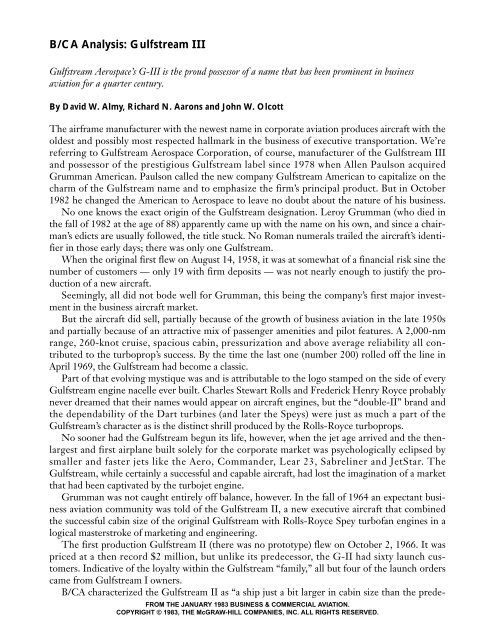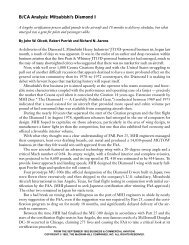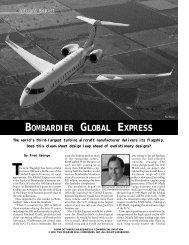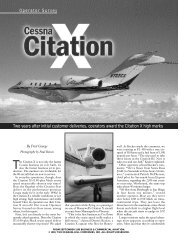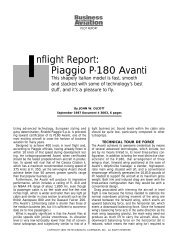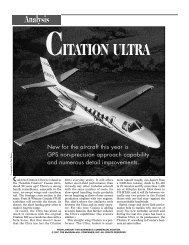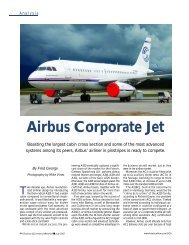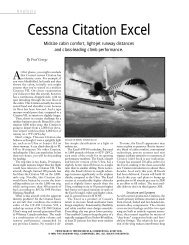B/CA Analysis: Gulfstream III - CompAir Logo
B/CA Analysis: Gulfstream III - CompAir Logo
B/CA Analysis: Gulfstream III - CompAir Logo
You also want an ePaper? Increase the reach of your titles
YUMPU automatically turns print PDFs into web optimized ePapers that Google loves.
B/<strong>CA</strong> <strong>Analysis</strong>: <strong>Gulfstream</strong> <strong>III</strong><br />
<strong>Gulfstream</strong> Aerospace’s G-<strong>III</strong> is the proud possessor of a name that has been prominent in business<br />
aviation for a quarter century.<br />
By David W. Almy, Richard N. Aarons and John W. Olcott<br />
The airframe manufacturer with the newest name in corporate aviation produces aircraft with the<br />
oldest and possibly most respected hallmark in the business of executive transportation. We’re<br />
referring to <strong>Gulfstream</strong> Aerospace Corporation, of course, manufacturer of the <strong>Gulfstream</strong> <strong>III</strong><br />
and possessor of the prestigious <strong>Gulfstream</strong> label since 1978 when Allen Paulson acquired<br />
Grumman American. Paulson called the new company <strong>Gulfstream</strong> American to capitalize on the<br />
charm of the <strong>Gulfstream</strong> name and to emphasize the firm’s principal product. But in October<br />
1982 he changed the American to Aerospace to leave no doubt about the nature of his business.<br />
No one knows the exact origin of the <strong>Gulfstream</strong> designation. Leroy Grumman (who died in<br />
the fall of 1982 at the age of 88) apparently came up with the name on his own, and since a chairman’s<br />
edicts are usually followed, the title stuck. No Roman numerals trailed the aircraft’s identifier<br />
in those early days; there was only one <strong>Gulfstream</strong>.<br />
When the original first flew on August 14, 1958, it was at somewhat of a financial risk sine the<br />
number of customers — only 19 with firm deposits — was not nearly enough to justify the production<br />
of a new aircraft.<br />
Seemingly, all did not bode well for Grumman, this being the company’s first major investment<br />
in the business aircraft market.<br />
But the aircraft did sell, partially because of the growth of business aviation in the late 1950s<br />
and partially because of an attractive mix of passenger amenities and pilot features. A 2,000-nm<br />
range, 260-knot cruise, spacious cabin, pressurization and above average reliability all contributed<br />
to the turboprop’s success. By the time the last one (number 200) rolled off the line in<br />
April 1969, the <strong>Gulfstream</strong> had become a classic.<br />
Part of that evolving mystique was and is attributable to the logo stamped on the side of every<br />
<strong>Gulfstream</strong> engine nacelle ever built. Charles Stewart Rolls and Frederick Henry Royce probably<br />
never dreamed that their names would appear on aircraft engines, but the “double-II” brand and<br />
the dependability of the Dart turbines (and later the Speys) were just as much a part of the<br />
<strong>Gulfstream</strong>’s character as is the distinct shrill produced by the Rolls-Royce turboprops.<br />
No sooner had the <strong>Gulfstream</strong> begun its life, however, when the jet age arrived and the thenlargest<br />
and first airplane built solely for the corporate market was psychologically eclipsed by<br />
smaller and faster jets like the Aero, Commander, Lear 23, Sabreliner and JetStar. The<br />
<strong>Gulfstream</strong>, while certainly a successful and capable aircraft, had lost the imagination of a market<br />
that had been captivated by the turbojet engine.<br />
Grumman was not caught entirely off balance, however. In the fall of 1964 an expectant business<br />
aviation community was told of the <strong>Gulfstream</strong> II, a new executive aircraft that combined<br />
the successful cabin size of the original <strong>Gulfstream</strong> with Rolls-Royce Spey turbofan engines in a<br />
logical masterstroke of marketing and engineering.<br />
The first production <strong>Gulfstream</strong> II (there was no prototype) flew on October 2, 1966. It was<br />
priced at a then record $2 million, but unlike its predecessor, the G-II had sixty launch customers.<br />
Indicative of the loyalty within the <strong>Gulfstream</strong> “family,” all but four of the launch orders<br />
came from <strong>Gulfstream</strong> I owners.<br />
B/<strong>CA</strong> characterized the <strong>Gulfstream</strong> II as “a ship just a bit larger in cabin size than the prede-<br />
FROM THE JANUARY 1983 BUSINESS & COMMERCIAL AVIATION.<br />
COPYRIGHT © 1983, THE McGRAW-HILL COMPANIES, INC. ALL RIGHTS RESERVED.
cessor <strong>Gulfstream</strong>, but the only “commonality” with the turboprop (that Grumman will admit to)<br />
is a hydraulic valve in the flap system.”<br />
Capitalizing on their preeminence in the business jet market during the early 1970s, the wise<br />
marketers at Grumman dubbed their G-II “The Ultimate.” Their advertising stylishly echoed<br />
that of Rolls-Royce motorcars. It was a soft sell with a strong machine. There were never any<br />
unsold aircraft on Grumman’s ramp.<br />
But the <strong>Gulfstream</strong> II was not without problems. Although the reliability and passenger appeal<br />
of the airplane remained unsurpassed throughout the 1970s, the soaring cost of fuel, range (most<br />
transatlantic trips required a fuel stop), public sensitivity to noise and some increasingly formidable<br />
competition necessitated some changes in the G-II design.<br />
The <strong>Gulfstream</strong> II’s range was subsequently increased by 500 nm through the convenient<br />
addition of tip tanks. Hush kits largely eliminated the granite-splitting crackle of full-power G-II<br />
takeoffs and brought the aircraft in line with FAR Part 36 requirements.<br />
But the problem of fuel efficiency remained. Three options were available: A major aerodynamic<br />
cleanup, use of more efficient engines or a mix of both.<br />
During three years of research and development, two primary areas were targeted for aerodynamic<br />
improvement: the forward fuselage (the cockpit and the nose) and the wing. In addition,<br />
several reengining options were seriously considered, and performance projections were finally<br />
calculated on two-, three-, and four-engine configurations.<br />
Enter, <strong>Gulfstream</strong> <strong>III</strong><br />
Rather than develop an entirely new wing for the follow-on aircraft, soon to be known as the<br />
<strong>Gulfstream</strong> <strong>III</strong>, Grumman engineers employed advanced techniques in computational aerodynamics<br />
and blended the results with wind tunnel data to design a modification to the G-II’s airfoil<br />
shape and wing planform. The wing’s chord was extended forward and its leading-edge geometry<br />
was changed, resulting in a thinner, more aerodynamically efficient airfoil section with better<br />
drag characteristics. Wingspan was increased by nine feet for better performance on takeoff and<br />
at altitude, and four-foot winglets were grafted onto the wingtips to lower induced drag.<br />
(Originally, there were four winglets planned for the G-<strong>III</strong>, one extending upward and one probing<br />
downward from each tip. But the lower, smaller winglets were marginally effective and were<br />
eliminated.)<br />
Although the modified wing was not as efficient as if Grumman’s engineers had started from<br />
scratch, its lower drag rise at high Mach numbers and its ability to sustain the <strong>Gulfstream</strong> at FL<br />
450 (and higher; the G-<strong>III</strong> holds the altitude record 52,000 feet — for its weight class) contributed<br />
to a 15- to 17-percent increase in specfic range when compared with the G-II.<br />
A redesigned nose also improved the <strong>Gulfstream</strong>’s performance by shifting rearward a shock<br />
wave that, in cruise, emanates from the fuselage’s curvature just aft of the cockpit. Consequently,<br />
the G-<strong>III</strong> enjoys a quieter cockpit than its predecessor since now the shock dances relatively<br />
unnoticed in the region between the cockpit and the passenger cabin.<br />
Despite concerted efforts to find an engine for the G-<strong>III</strong> with a less voracious affinity for jet A,<br />
none were deemed suitable. Reliability and high-altitude performance were cited as the principal<br />
reasons for retaining the Speys. Statistically, you can expect an inflight shutdown only once in<br />
every 50,000 hours of operation.<br />
In addition, further analysis of specific fuel consumption and power output at altitude indicated<br />
that above FL 410, the venerable Speys, with their very low (0.62:1) bypass ratios, were the<br />
best engines available for the job.<br />
A glance at the Comparison Profile suggests why the G-<strong>III</strong> does well in upholding the<br />
FROM THE JANUARY 1983 BUSINESS & COMMERCIAL AVIATION.<br />
COPYRIGHT © 1983, THE McGRAW-HILL COMPANIES, INC. ALL RIGHTS RESERVED.
<strong>Gulfstream</strong> tradition. Ranking or tieing for first in 14 of the 28 categories B/<strong>CA</strong> used to compare<br />
the G-<strong>III</strong> against the composite characteristics of its competitors — the Canadair Challenger<br />
CL-600 and the AMD Falcon 50 — the <strong>Gulfstream</strong> shines in its ability to carry a maximum useful<br />
load of 30,900 pounds. Much of that capacity, however, is used to lift the fuel that provides an<br />
impressive VFR, tanks-full range (with NBAA reserves) of 4,150 nm — tops among the aircraft<br />
considered.<br />
In the categories that relate to fuel flow, the G-<strong>III</strong> produces numbers that place significantly<br />
below average due to the low bypass ratio and older technology of the Spey engine. Note, however,<br />
that the noise performance of the G-<strong>III</strong> is only 6 percent below the average on takeoff and 2<br />
percent lower in the approach configuration.<br />
The G-<strong>III</strong> meets Stage II of the Part 36 noise standards, without the use of any special noiseabatement<br />
procedures. But when <strong>Gulfstream</strong>’s “flex EPR” technique is followed, whereby a<br />
reduced power setting is used to achieve but not exceed a Part 25 takeoff profile (even with an<br />
engine cut at V1, and no power adjustment), the 90 EPNdB noise footprint can be reduced in<br />
size by as much as 76 percent.<br />
Something More<br />
Competitive performance partially accounts for the G-<strong>III</strong>’s success, but reliability and flying<br />
qualities play major roles in sustaining the <strong>Gulfstream</strong> image.<br />
Reliability dominates the G-<strong>III</strong> design: There is a back-up system for nearly every back-up<br />
system. For example, there are four boost pumps in the fuel system, but the aircraft can operate at<br />
FL 450 with only one functional, provided the cross-flow is open. And yes, there are two means<br />
of providing cross flow between the fuel tanks.<br />
Although the electrical system also enjoyed the redundancy for which <strong>Gulfstream</strong>s are well<br />
known, <strong>Gulfstream</strong> Aerospace’s new demonstrator (due out of <strong>Gulfstream</strong>’s own completion center<br />
in March 1983) as well as aircraft beyond serial number 402 will use two Bendix variablespeed,<br />
constant-frequency AC alternators for their primary sources of electrical power. Each unit<br />
is rated at 23kVA and can carry the aircraft’s total electrical load. Direct current (other than battery<br />
power) will be obtained by means of rectifiers; however, other aspects of the new electrical<br />
system, such as the aircraft I’s split-bus arrangement, will remain the same as on older G-<strong>III</strong>s.<br />
By selecting AC as the primary source of electrical power, <strong>Gulfstream</strong> Aerospace simplified<br />
the system and saved about 200 pounds of weight. Pilot work load is reduced by more automatic<br />
sensing of anomalies and improved fault-protection logic, and outfitters have a greater latitude in<br />
their selection of special equipment for the aircraft.<br />
The new G-<strong>III</strong>s also will enjoy the advantages of an auxiliary power unit that is approved for<br />
operation at altitudes up to FL 300. The APU can be started up to FL 200 and will have the same<br />
capacity for producing AC as that of the engine-driven Bendix alternators.<br />
Rounding out the revamped G-<strong>III</strong> electrical system will be a new overhead electrical panel,<br />
with simplified readouts that show percent capacity.<br />
<strong>Gulfstream</strong> Aerospace’s new demonstrator also will feature dual Sperry ED-800 electronic<br />
flight instrumentation systems as well as Sperry’s Primus 800 multifunctional display. But the<br />
timing of available, FAA-approved hardware prevented <strong>Gulfstream</strong> Aerospace from selecting an<br />
electronic engine instrumentation and crew alerting system. Howell round-dial instrumentation<br />
with digital readouts, however, will be used in the new demonstrator, serial number 357.<br />
Another advanced feature of serial number 357 will be its three Honeywell ring laser gyros,<br />
which will provide heading reference for the aircraft’s compass and inertial navigation systems. The<br />
Honeywell units save weight and improve reliability by eliminating the use of mechanical gyros.<br />
FROM THE JANUARY 1983 BUSINESS & COMMERCIAL AVIATION.<br />
COPYRIGHT © 1983, THE McGRAW-HILL COMPANIES, INC. ALL RIGHTS RESERVED.
Pilots enjoy the G-<strong>III</strong> not only for the reliability that its redundant systems provide but for its<br />
favorable flying qualities as well. With sufficient power to climb unrestricted to FL 450 at its<br />
maximum takeoff weight of 68,200 pounds, and with its longer, wingless-enhanced wing providing<br />
comfortable stability and control even at FL 450, the G-<strong>III</strong> is a pleasure to fly. We were able<br />
to sustain a bank angle of 50- to 55-degrees without exciting a buffet at FL 450 and about 52,000<br />
pounds. And we found the aircraft’s stall behavior at that altitude to be predictable and without<br />
violence as the stick shaker and pusher did their respective jobs of stall warning and protection.<br />
Even with our lack of familiarity with the G-<strong>III</strong>, we recovered fully by FL 430.<br />
The G-<strong>III</strong>s speed stability and lateral and directional handling characteristics provide a comfortable<br />
platform for approach and landing tasks. The longer wings and winglets significantly<br />
lessen the roll sensitivity and tendency toward wing rocking that is found in the G-II in its<br />
approach configuration.<br />
While it is the passengers who must pass final judgment (since they pay the bills), certainly the<br />
feelings of confidence that come from <strong>Gulfstream</strong> reliability and pilot praise help sell G-<strong>III</strong>s.<br />
<strong>Gulfstream</strong> Aerospace’s dedication to the business aviation community as well as the 25-year-old<br />
<strong>Gulfstream</strong> tradition also are significant factors, no doubt.<br />
Proof of the <strong>Gulfstream</strong> appeal is the fact that during this past year, while most of the business<br />
aviation industry was wallowing in an economic quagmire, <strong>Gulfstream</strong> Aerospace’s Savannah<br />
division was running at full capacity.<br />
And <strong>Gulfstream</strong>’s future looks bright too. Looming large on the horizon is the G-IV, another<br />
twin engine growth version of the G-I that will include one major modification: a new turbofan.<br />
Those resourceful people at Rolls-Royce, enticed by visions of hundreds of retrofitted BAC One<br />
Eleven’s, Fokker F28s, G-IIs and G-<strong>III</strong>s, have come up with a new Spey derivative to match the<br />
<strong>Gulfstream</strong> airframe. The Rolls-Royce RB183-03 will be a 13,900 pound-thrust turbofan derated<br />
to 12,000 pounds thrust for use in the G-IV. Certification of the <strong>Gulfstream</strong> IV is expected in<br />
1986, provided Rolls-Royce announces a go-ahead on the RB183-03 this month.<br />
If the past 25 years are any indication, future versions of the <strong>Gulfstream</strong> are likely to be just as successful<br />
as their predecessors, for that name holds a special place in the annals of business aviation. B/<strong>CA</strong><br />
FROM THE JANUARY 1983 BUSINESS & COMMERCIAL AVIATION.<br />
COPYRIGHT © 1983, THE McGRAW-HILL COMPANIES, INC. ALL RIGHTS RESERVED.


